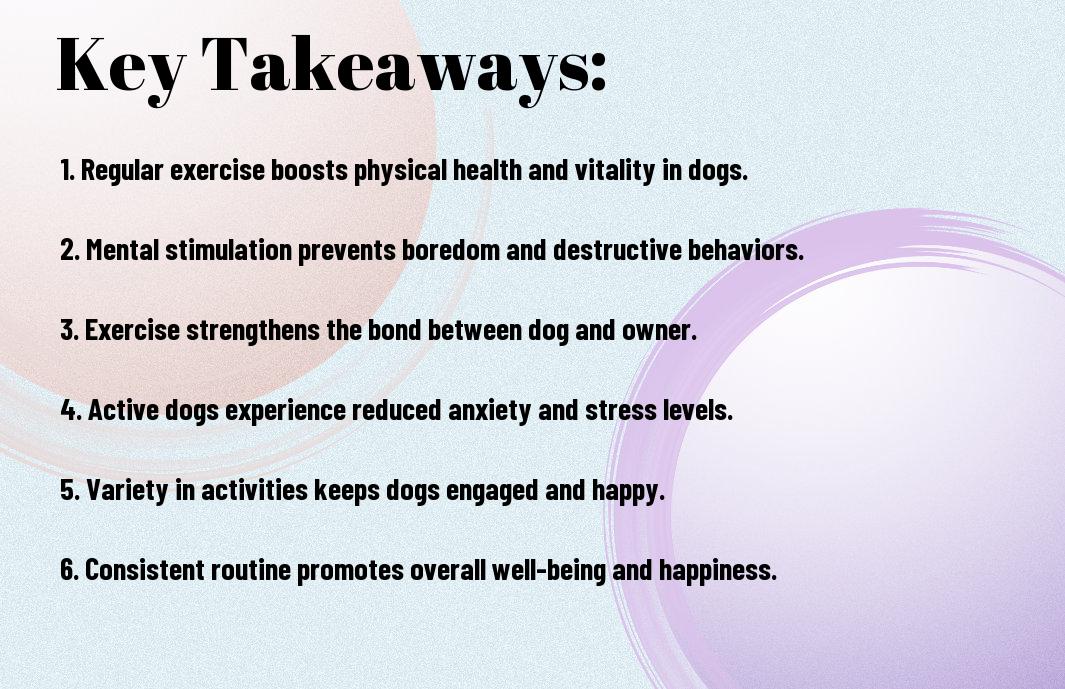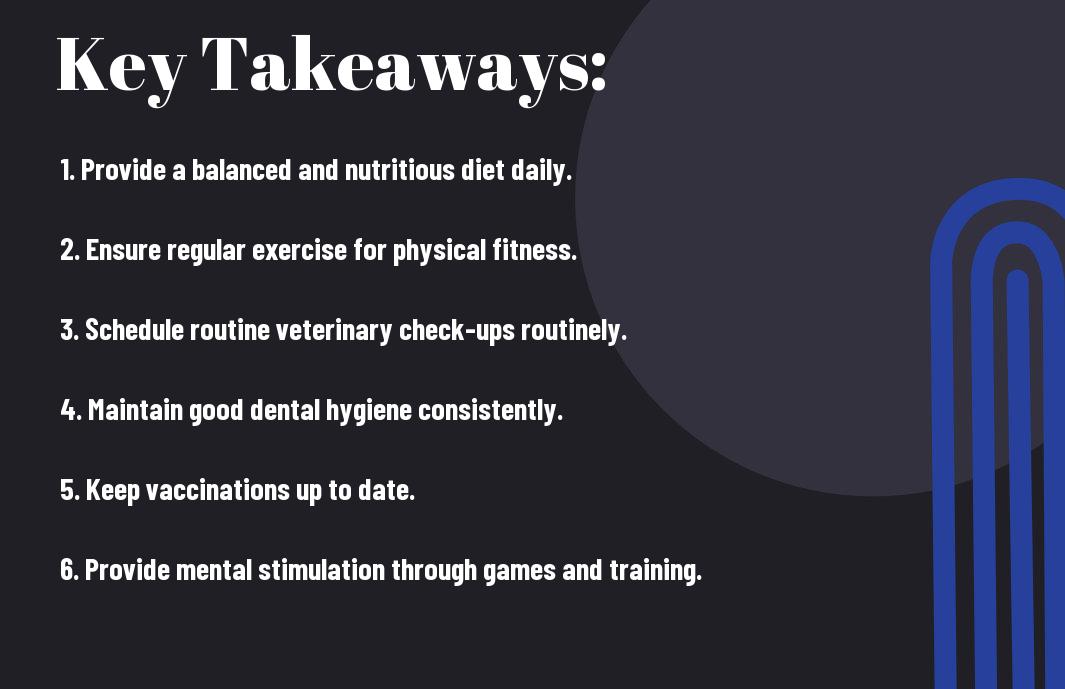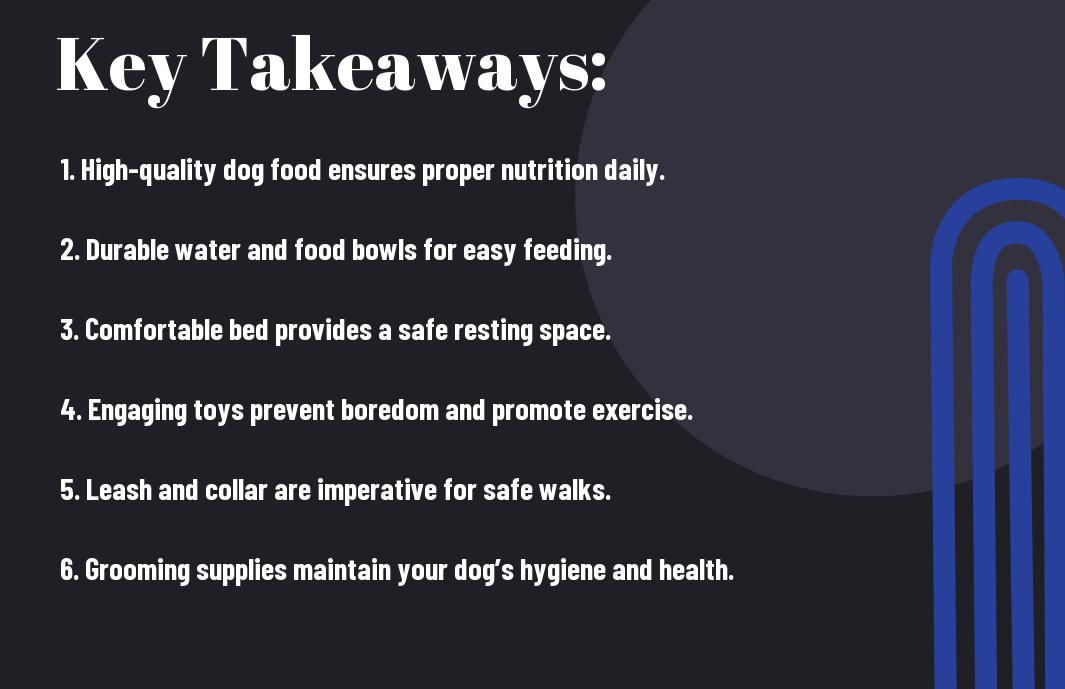Mental enrichment and physical activity are vital for your dog’s overall well-being. Regular exercise not only keeps your furry friend healthy, but it also helps prevent behavioral issues that stem from boredom and anxiety. By engaging your dog in stimulating activities and providing opportunities for play, you can enhance their cognitive abilities and strengthen your bond. As a responsible pet owner, understanding how to meet your dog’s physical and mental needs is vital for a happy, balanced life together.


The Benefits of Regular Exercise
Physical Health
The health of your dog is directly influenced by the amount of exercise they receive. Regular physical activity helps prevent obesity, which is a common issue in pets today. When your dog engages in consistent exercise, it promotes a healthy weight, reduces the risk of chronic diseases, and enhances the overall quality of life. Your dog’s cardiovascular health also benefits; aerobic activities strengthen the heart and increase lung capacity, allowing your furry friend to thrive for years to come.
Additionally, exercise is vital for maintaining joint health and preventing issues such as arthritis. Regular movement ensures that your dog’s muscles remain strong and flexible, supporting their joints and improving their mobility. You’ll find that dogs who are regularly exercised tend to be more energetic and vibrant, displaying a youthful spirit even as they age.
Behavioral Improvements
Regular exercise serves as an outlet for your dog’s pent-up energy, leading to significant behavioral improvements. A well-exercised dog is often a more balanced and calm companion. If you notice your dog exhibiting behaviors such as excessive barking, digging, or chewing, you may find that increasing their exercise routine directly alleviates these issues. Engaging in physical activities allows your dog to focus their energy positively, reducing stress and anxiety.
Benefits of regular exercise extend beyond physical advantages. A dog that has an established routine of daily walks or playtime is less likely to engage in destructive behaviors that stem from boredom or anxiety. By giving your dog the opportunity to explore new environments and socialize with other pets, you create a well-adjusted and confident companion who thrives in various situations.
Types of Exercise for Dogs
For your dog to thrive, it’s vital to provide them with a variety of exercises that cater to their physical and mental needs. Regular movement not only keeps your pet healthy but also strengthens the bond between you two through shared activities. Below is a breakdown of the different types of exercise you can consider for your furry friend:
| Type of Exercise | Description |
| Walking and Running | Daily walks and runs can greatly benefit your dog’s physical health. |
| Interactive Games | Engaging your dog in games stimulates their mind and encourages physical activity. |
| Structured Activities | Formal activities like agility training or obedience classes enhance discipline and focus. |
| Socialization | Exposure to other dogs and environments can help your pet develop social skills. |
| Free Play | Letting your dog play freely in a safe area allows for creativity and self-exploration. |
Walking and Running
The simplest form of exercise for dogs is walking and running. These activities are easily incorporated into your daily routine and can be adjusted according to your dog’s energy levels and physical abilities. Regular walks provide vital physical exercise, while also exposing your dog to new sights, smells, and experiences, all of which are vital for their mental stimulation.
Running can be more vigorous and is ideal for high-energy dogs that need an outlet for their excess energy. You might consider taking your dog on longer runs or jogging alongside them. Just be sure to monitor their behavior while exercising and allow for rest breaks, especially in warm weather.
Interactive Games
An excellent way to blend exercise with mental stimulation is through interactive games. These activities not only help in burning off excess energy but also keep your dog engaged and mentally sharp. Games like fetch, tug-of-war, and hide-and-seek are not only fun but also constructive in strengthening the bond between you and your pet.
Dogs enjoy the challenge of needing to think and navigate to find toys or treats. By incorporating these games into your routine, you provide both mental and physical stimulation, ensuring your dog remains well-balanced and happy.
Dogs thrive on interaction, and the thrill of playing games also encourages various physical movements that contribute to their overall well-being. By combining playtime with consistent exercise, you will not only enhance your pet’s fitness but also support their mental health.
Structured Activities
Along with casual play and walks, structured activities such as agility training, obedience classes, or dog sports provide more focused exercise. These activities require your dog to follow instructions, navigate obstacles, and perform specific tasks, which can significantly improve their concentration and confidence.
Participating in structured activities not only proves beneficial for your dog’s physical health but also helps you communicate better with them. These sessions are great opportunities to reinforce good behavior, create a routine, and provide both physical exertion and mental exercise.
Structured activities can lead to significant improvements in your dog’s manners and social skills, making them more adaptable to different environments and situations. Not only will your dog become more engaged, but you’ll also see changes in their overall demeanor, as they become more balanced and well-rounded.
This variety of exercises will enrich your dog’s life, fostering a happier and healthier companion.

The Role of Mental Stimulation
Many dog owners may not realize that mental stimulation plays a vital role in their pets’ overall well-being. Just like humans, dogs need mental challenges to thrive. Engaging your dog in activities that require thinking or problem-solving can lead not only to better behavior but also to improved cognitive functions, similar to how a good book or puzzle can keep your mind sharp.
Cognitive Development
Among the many benefits of mental stimulation, cognitive development is particularly significant. Engaging your dog in tasks that require mental effort can help sharpen their problem-solving skills and enhance their ability to learn new commands. Through activities such as puzzle toys, obedience training, or even scent work, you provide your dog with the opportunity to think critically and adapt to new circumstances.
Additionally, this cognitive exercise helps strengthen your dog’s brain health, much like regular physical activity keeps their body fit. When you challenge your dog mentally, you stimulate areas of their brain responsible for memory and reasoning, which can lead to a happier and more well-rounded canine companion.
Prevention of Boredom
Around many households, boredom is a common issue for dogs, especially those left alone for long periods. When dogs do not receive enough mental stimulation, they may resort to destructive behaviors, such as chewing on furniture or digging. By incorporating various engaging activities into your dog’s routine, you can keep their minds stimulated and stave off boredom and restlessness.
To prevent boredom, consider rotating toys, introducing new games, or signing up for agility or trick training classes. Regularly changing activities keeps your dog intrigued and provides an exciting challenge for their minds. Additionally, a mentally engaged dog is less likely to engage in undesirable behaviors, contributing to a more harmonious household.
Enhanced Bonding with Owners
Development of your relationship with your dog often hinges on shared experiences and activities. By participating in mental stimulation exercises together, you foster a deeper bond and understanding. Activities such as interactive games, training sessions, or even casual problem-solving tasks promote cooperative learning and strengthen your connection through teamwork.
Moreover, the enjoyment you share during these activities leads to positive reinforcement and trust. As your dog learns to depend on you for guidance in mental challenges, they grow more confident and appreciative of your companionship. Incorporating mental stimulation into your dog’s routine is not just about keeping them occupied; it’s also an avenue for enhancing your relationship.
Cognitive engagement with your dog not only fosters skills but also creates emotional connections. Sharing moments of success during training or play helps build a foundation of trust and joy. Your dog thrives when they feel valued and understood, making mental stimulation a key component of a happy, healthy life together.
Techniques for Mental Stimulation
Keep in mind that mental stimulation is just as important for your dog as physical exercise. Engaging your furry friend’s brain can lead to a happier, more well-adjusted pet. There are various techniques you can employ to achieve this, ensuring that your dog remains both mentally and emotionally satisfied. Implementing these activities into your routine can help prevent behavioral issues that stem from boredom and restlessness.
Puzzle Toys
At the heart of effective mental stimulation are puzzle toys. These interactive toys require your dog to solve a problem to receive a reward, often in the form of treats or kibble. By challenging your dog with varying difficulty levels, you can tailor the experience to fit their specific needs. This kind of stimulation not only promotes critical thinking skills but also provides your dog with an opportunity to harness their natural instincts to ‘hunt’ for food.
Additionally, puzzle toys break the monotony of everyday life for your dog. By incorporating them into your playtime routine, you can enhance their problem-solving abilities. Experimenting with different types of puzzle toys can yield exciting results, as your dog learns new ways to engage with their environment.
Training Sessions
Above all, regular training sessions contribute significantly to your dog’s mental stimulation. Engaging in obedience training or teaching new tricks keeps your dog mentally engaged and helps strengthen the bond between you and your pet. It provides a structured way for your dog to learn and gives them a purpose, making them feel more secure in their surroundings.
Due to the creative nature of training sessions, they can be tailored to suit your dog’s individual capabilities and interests. Start with simple commands and gradually increase the complexity as your dog begins to excel. This not only boosts their confidence but also keeps their mind alert and ready for new challenges. Keep these sessions short yet frequent to maintain your dog’s enthusiasm and focus.
Socialization Opportunities
Before you can fully develop your dog’s mental stimulation, it’s important to provide them with opportunities to socialize. Interacting with other dogs and people helps your dog learn important social cues and behaviors. These experiences can significantly enrich your dog’s life, reducing anxiety and boosting their confidence as they interact within their community. Regularly exposing your dog to different environments and situations will help to develop a well-rounded character.
This practice not only prevents boredom but also encourages your dog to think on their feet, adapting to new experiences effectively. Consider organizing playdates with other dog owners or participating in group training classes to enhance their social skills and mental capacity. These experiences will prove invaluable for your dog’s overall happiness and well-being.
Creating a Balanced Routine
Unlike humans, dogs depend primarily on their owners to create a fulfilling and dynamic daily routine. A balanced routine should encompass both physical exercise and mental stimulation, ensuring your dog remains healthy, happy, and well-adjusted. This structure not only benefits your pet’s physical health but also enhances their cognitive function, reducing the likelihood of behavioral issues stemming from boredom or inactivity.
Determining Exercise Needs
One of the key components of a balanced routine is determining your dog’s specific exercise needs. These needs can vary based on factors such as breed, age, energy level, and overall health. For example, a high-energy breed such as a Border Collie may require more vigorous activities than a more laid-back breed like a Bulldog. By understanding your dog’s unique requirements, you can tailor a fitness regimen that keeps them engaged and physically fit.
Additionally, it’s vital to consider your dog’s age and any potential health concerns. Puppies typically have boundless energy and need ample opportunities for physical play, while senior dogs might benefit from gentler walks and low-impact activities. Regular veterinary check-ups can also provide vital insights into what type of exercise is suitable for your dog’s age and health status.
Incorporating Mental Challenges
Determining your dog’s mental stimulation needs is just as important as assessing their physical requirements. Incorporating mental challenges into their routine can help improve focus, reduce anxiety, and provide an outlet for their natural instincts. Activities like puzzle toys, obedience training, or scent games can offer your dog the mental workout they need to stay sharp and engaged.
Mental stimulation is vital for your dog’s overall well-being. Interactive toys that dispense treats, for example, encourage your dog to problem-solve and think independently. This not only keeps them busy but also strengthens the bond you share, as they learn to rely on your guidance and support during these activities. By mixing mental challenges with physical exercise, you’re laying the groundwork for a well-rounded pet who thrives in both body and mind.
Scheduling Daily Activities
The final piece of creating a balanced routine is scheduling daily activities. Having a set time for walks, playtime, and mental exercises fosters a sense of stability for your dog, helping them understand when to expect different activities. This structure can help reduce anxiety and promote a sense of security, making it easier for your furry friend to adapt to their environment.
Consequently, you should aim to establish a schedule that suits both you and your dog. This can include regular morning walks, afternoon training sessions, and evening playtime. Feel free to mix and match activities to keep things interesting and engaging for your dog while ensuring their physical and mental needs are met consistently.
Common Misconceptions
After discussing the significance of regular exercise and mental stimulation for dogs, it’s vital to address some common misconceptions surrounding these topics. Many pet owners may hold onto beliefs that could hinder their dogs’ health and well-being. By debunking these myths, you can create a better environment for your furry friend and enhance their quality of life.
Exercise Requirements for Different Breeds
At times, dog owners may underestimate the exercise needs of their specific breed. It’s a misconception that all dogs require the same amount of exercise. Breeds like Border Collies and Labrador Retrievers thrive on high levels of physical activity, often requiring over an hour of vigorous exercise daily. On the other hand, smaller or older breeds, such as Bulldogs or Dachshunds, may need less physical exertion. Understanding the unique needs of your breed is vital in providing appropriate exercise routines.
At the same time, there’s a tendency to overestimate the exercise requirements of smaller dogs, thinking they don’t need as much physical activity as larger breeds. While it’s true that they may have smaller legs and shorter strides, energetic small breeds, like Jack Russell Terriers and Chihuahuas, often require just as much playtime and stimulation to stay healthy and well-adjusted. Tailoring exercise to fit your dog’s breed will help them lead a happier, healthier life.
Overworking Younger Dogs
Behind the misconception that more exercise is always better lies the misunderstanding surrounding the physical development of young dogs. Growing puppies may have boundless energy, but their bodies are still developing, and excessive exercise can lead to injuries that impede their growth. It’s important to balance playtime and exercise to allow for adequate rest and recovery while ensuring young dogs enjoy physical activity. Short, controlled bursts of play can be far more beneficial than long, strenuous sessions.
Another key aspect to keep in mind is that young dogs are still learning how to gauge their limits, which makes it easy for them to overexert themselves. As a responsible pet owner, you should establish a routine that matches their developmental stage, focusing on flexible schedules that include rest periods and less intense play. This consideration helps avoid potential injury while still providing the joy and benefits of regular exercise.
The Myth of Indoor Play
At first glance, many owners may feel that indoor play is sufficient for their dogs’ exercise needs. Fetching a ball down a corridor or engaging in tug-of-war may seem like ample activity. However, this perspective fails to recognize that most dogs, especially high-energy breeds, require more than just limited indoor activity. Outdoor environments provide not just room to run and play but also expose your dog to new smells, sights, and interactions that are crucial for their mental stimulation.
At the same time, don’t overlook the importance of incorporating outdoor activities into your dog’s routine. Activities like hiking, visiting dog parks, or simply taking a stroll around the neighborhood can lead to a healthier and happier pet. These experiences enrich your dog’s life by providing both physical exercise and mental engagement, greatly benefiting their overall well-being.
Exercise goes beyond just physical activity; it’s about creating an environment where your dog can thrive mentally and physically. The misconception that indoor play alone suffices can hinder your dog’s development, so expanding their experiences with outdoor activities combined with structured playtime will ultimately lead to a fulfilling and balanced lifestyle.
Conclusion
Conclusively, ensuring that your dog receives regular exercise and mental stimulation is imperative for their overall well-being. Engaging in physical activities not only helps to maintain your dog’s health but also plays a significant role in preventing behavioral issues. When you incorporate daily walks, playtime, or fetch into your routine, you contribute to your dog’s physical fitness and help in reducing anxiety and stress. This physical engagement allows your dog to expend energy in productive ways, enhancing the bond you share and enriching their quality of life.
Moreover, mental stimulation is equally important in keeping your dog’s mind sharp and attentive. By introducing puzzle toys, training sessions, or interactive games, you can provide stimulating experiences that challenge your dog’s intellect and prevent boredom. This mental engagement is vital for your dog’s happiness, making it imperative to find creative ways to keep their mind active. As you spend time exercising and mentally stimulating your dog, you not only support their health and happiness but also foster a deeper, more rewarding companionship that benefits both of you.
FAQ
Q: Why is regular exercise important for dogs?
A: Regular exercise is vital for dogs as it helps to maintain their physical health, weight, and overall well-being. Engaging in daily activities like walking, playing fetch, or running allows dogs to expend energy, which can reduce the likelihood of behavioral issues such as excessive barking or destructiveness. Additionally, physical activity supports healthy muscle development, cardiovascular health, and strengthens joints, contributing to a dog’s longevity and quality of life.
Q: How does mental stimulation benefit dogs?
A: Mental stimulation is key for a dog’s cognitive health and emotional balance. Activities such as puzzle toys, obedience training, or scent games challenge their minds and help prevent boredom. A mentally engaged dog is often happier and more content, which can lead to improved behavior. Furthermore, stimulating activities can enhance problem-solving skills, improve focus, and even reduce anxiety levels, ensuring a well-rounded and balanced lifestyle for your pet.
Q: How can I combine exercise and mental stimulation for my dog?
A: Combining exercise and mental stimulation can be an enjoyable experience for both you and your dog. Activities like agility training or interactive games that require your dog to navigate obstacles keep them physically active while also engaging their minds. Incorporating commands and tricks into playtime, using fetch with a twist (like having them find the toy first), or enrolling in dog sports are excellent ways to achieve this balance. By ensuring that your dog’s exercise routine also includes mental challenges, you can provide them with a fulfilling and enriching environment.










